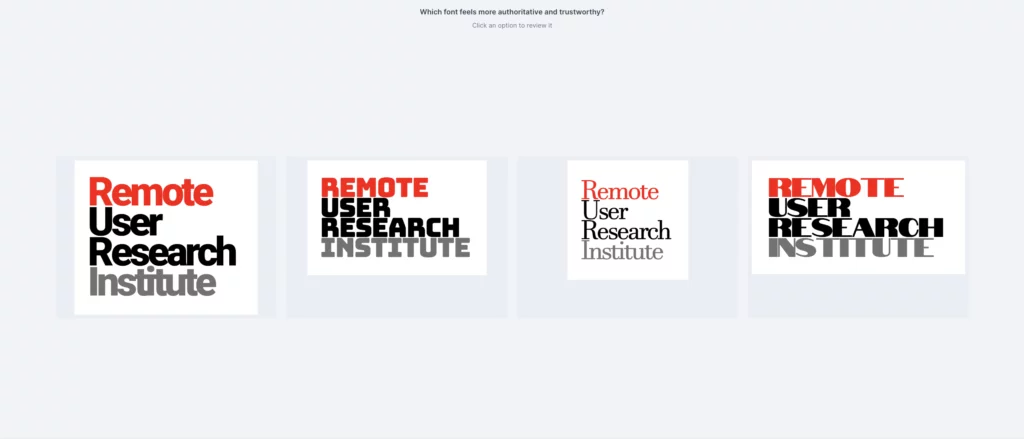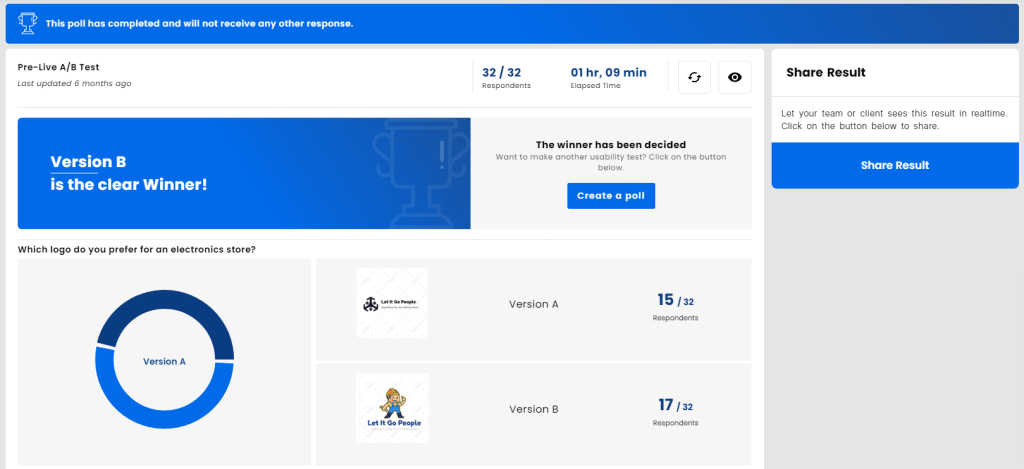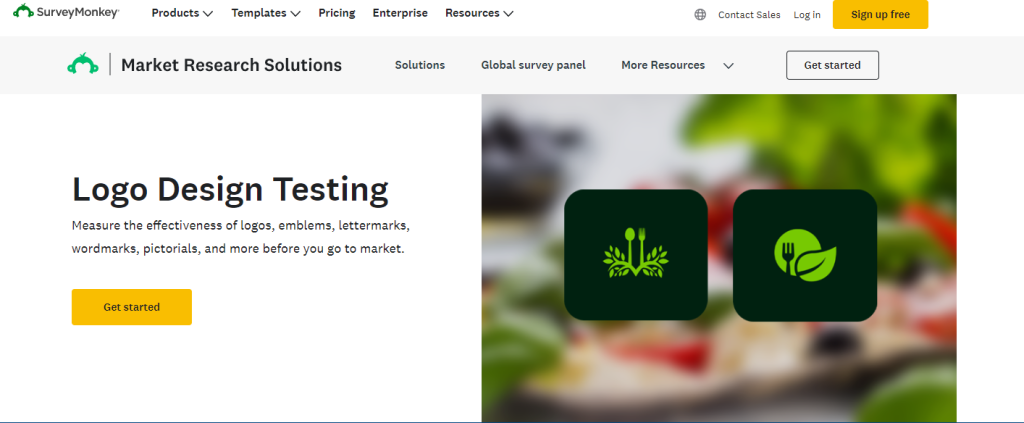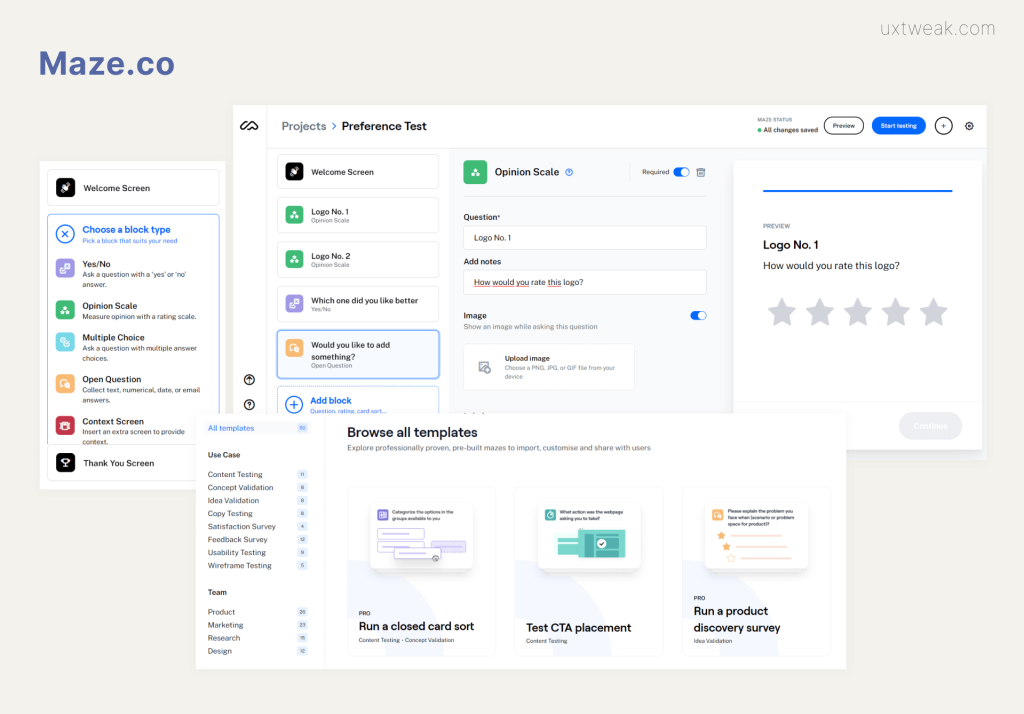Picture this: Your company has just revamped its logo, requiring considerable time and financial investment. Now, you’re eager to showcase it on your website, but there needs to be more attention about how your customers will perceive it. Instead of fretting, why not seek their opinions directly?
That’s where preference testing comes into play. If you need help with how to conduct one, fear not. We’ve crafted a comprehensive guide to walk you through the process, complete with sample questions and preference test examples.
What is Preference Testing?

Preference testing is a research method aimed at establishing preferences among various options. Participants are presented with two or more alternatives and asked to choose their preferred option. This method determines which designs are most aesthetically pleasing, understandable, or generate the most trust.
Preference testing can be applied to various design aspects, including logos, icons, color palettes, overall design concepts, mockups, content, copy, and text styles. By conducting preference tests, designers gain valuable insights into consumer preferences, enabling them to create products that better meet user needs.
For example, in logo design, participants may be presented with two different logo styles and asked to choose their preferred option. Their feedback reveals which designs are favored and provides insights into the reasons behind their choices. This feedback helps designers refine their designs until they arrive at the optimal solution.
Preference testing is most effective when conducted in the early stages of the design process, ideally during the initial design phase or early prototyping stages. By obtaining early feedback, designers can identify which options resonate most with their target audience and decide which direction to pursue.
Advantages of Preference Testing:
- Customer-Centric Product Development: Preference testing tools allow businesses to understand customer preferences and priorities, enabling them to develop products that better meet consumer needs and preferences. By aligning product features with customer preferences, businesses can enhance customer satisfaction and loyalty.
- Optimized Product Offerings: Preference testing helps businesses identify the most desirable product configurations or attribute levels among different options. This information enables companies to optimize their product offerings, focusing on features that resonate most with their target audience and eliminating less preferred options.
- Informed Decision-Making: Preference testing provides data-driven insights into consumer preferences, empowering businesses to make informed decisions about product development, pricing strategies, and marketing initiatives. By understanding which product features matter most to their customers, businesses can allocate resources more effectively and prioritize initiatives that drive value.
- Competitive Advantage: By leveraging preference testing tools, businesses can gain a competitive edge in the market by offering products that better meet customer needs and preferences compared to competitors. Understanding consumer preferences allows companies to differentiate their offerings, attract more customers, and increase market share.
- Reduced Risk: Preference testing helps mitigate the risk associated with product development and marketing decisions by providing evidence-based insights into consumer preferences. By testing product concepts and features before launch, businesses can identify potential issues early on and make adjustments to optimize the chances of success.
- Cost Savings: Preference testing can help businesses avoid costly mistakes by guiding resource allocation towards features that are most valued by customers. By investing in features that drive the most value, businesses can optimize their product development process and reduce the likelihood of investing in features with limited market appeal.
- Enhanced Brand Perception: By consistently delivering products that align with customer preferences, businesses can enhance their brand perception and reputation in the market. Positive experiences with preferred products can lead to increased customer loyalty, positive word-of-mouth, and a strong brand image.
Difference Between A/B Testing Tools and Preference Testing Tools:

- Objective:
- A/B Testing Tools: A/B testing tools are primarily used to compare the performance of two or more variations of a single element, such as a webpage, email campaign, or advertisement. The objective is to determine which variation performs better in terms of a specific metric, such as click-through rate, conversion rate, or engagement.
- Preference Testing Tools: Preference testing tools, on the other hand, are used to assess consumer preferences for different product features or attributes. The objective is to understand which combination of features or attribute levels is most preferred by consumers.
- Focus:
- A/B Testing Tools: A/B testing focuses on optimizing existing elements or designs by comparing variations and selecting the one that performs better based on predefined metrics.
- Preference Testing Tools: Preference testing focuses on understanding customer preferences and priorities to inform product development decisions, such as feature prioritization, product design, or pricing strategies.
- Methodology:
- A/B Testing Tools: A/B testing typically involves randomly dividing users or participants into groups and exposing each group to a different variation of the element being tested. The performance of each variation is then measured and compared to determine the most effective one.
- Preference Testing Tools: Preference testing employs various methodologies, such as surveys, experiments, conjoint analysis, or MaxDiff analysis, to gather data on consumer preferences for different product features or attribute levels. Participants evaluate multiple options and provide feedback on their preferences.
- Use Cases:
- A/B Testing Tools: A/B testing is commonly used in digital marketing, website optimization, and user experience (UX) design to improve conversion rates, engagement, and overall performance of digital assets.
- Preference Testing Tools: Preference testing is used in product development, market research, and strategic decision-making to understand customer preferences, prioritize product features, and optimize product offerings to better meet customer needs.
Top Preference Testing Tools of 2024:
1. UsabilityHub

UsabilityHub, now known as Lyssna, is a remote user research platform that provides various testing tools to validate design decisions related to videos, logos, packaging, or animations. One of its key offerings is preference testing, which features a straightforward interface with essential functions.
Preference testing with UsabilityHub enables users to:
- Include welcome and final screens
- Upload designs to be tested
- Craft follow-up questions for participants
Additionally, the platform automatically calculates statistical significance when comparing two designs, providing testers with insights into the relevance of the results.
Recruitment options on UsabilityHub are twofold:
- Researchers can share study links with their testers at no extra cost.
- Alternatively, they can recruit participants from UsabilityHub’s expansive user panel, which boasts over 340,000 users.
As for pricing, UsabilityHub offers the following plans:
- Free version: Available for tests lasting up to 2 minutes.
- Basic plan: Starts at $89/month, allowing tests of up to 5 minutes.
- Pro plan: Priced at $199 per month, it includes multi-user plans, unlimited tests, and custom branding options.
2. Useberry

Useberry is a user testing service that provides various tools, including preference testing, to enhance the user testing experience. Their preference test tool is handy for testing microcopies, CTAs, variation performance, and design variations.
When utilizing Useberry’s preference testing tool, users can:
- Choose between image or text preference types
- Create tasks to guide participants
- Add follow-up questions for deeper insights
- Include intro and thank you screens to bookend the testing session
Recruitment options for testing with Useberry include:
- Bringing your testers to the platform.
- Recruiting participants from Useberry’s extensive user panel comprises over 240,000 users.
In terms of pricing, Useberry offers the following plans:
- Free plan: Allows users to collect up to 10 responses.
- Basic plan: Priced at 28€ (33$) per month, it includes 3 projects.
- Pro plan: Costs 57€ (67$) per month and offers unlimited tests and responses.
3. SurveyMonkey

SurveyMonkey is a versatile survey platform designed to help businesses gather and analyze feedback to fuel their growth and innovation strategies. While it primarily focuses on conducting surveys to collect insights from users, customers, or employees, its interface is geared toward more experienced users.
Preference testing in UX:
Although SurveyMonkey doesn’t offer a specific tool named “Preference test,” users can effectively conduct preference studies by creating surveys tailored to gather feedback and relevant data. This approach serves as a substitute for dedicated preference testing tools. SurveyMonkey is ideal for individuals seeking to distribute simple questionnaires, with comprehensive features and analysis reports available only in the Pro plan.
However, SurveyMonkey features a tool similar to Preference Study called “Product Concept Analysis.” This tool enables users to validate product concepts, feature optimizations, and ideas by leveraging a trusted audience, all within a short timeframe.
Recruitment Options:
Users have the flexibility to recruit participants from SurveyMonkey’s vast user panel, which boasts over 175 million users. Alternatively, users can opt to bring their testers to participate in surveys.
SurveyMonkey Pricing:
While SurveyMonkey offers a free version with limited features, its plan starts at 43€ (50$) per month. The Team plan, designed for at least three users, begins at 34€ (40$) per month. It’s worth noting that all plans are billed annually, which may pose a drawback for occasional users.
Learn about mobile testing here.
4. Maze

Maze is a comprehensive remote user testing platform that facilitates various testing activities, including preference testing, prototype evaluations, and feedback collection. It consolidates user feedback into a single interface, enabling teams to gather actionable insights collaboratively.
Preference testing in UX:
Maze offers versatile preference testing capabilities, allowing users to customize their tests block-by-block according to their specific requirements. Users can choose from various pre-made templates or create tests from scratch, tailoring them to their needs. Additionally, Maze enables users to include welcome and final screens to enhance the testing experience.
Recruitment Options:
For participant recruitment, Maze provides access to its extensive user panel, comprising over 70,000 users. Users can recruit targeted testers from this panel or utilize their testers at no additional cost, offering flexibility in participant selection.
Maze Pricing:
Like the platforms mentioned earlier, Maze offers a free version with limitations, allowing users to conduct up to three projects. The Pro plan starts at $75/month for more extensive testing needs, accommodating up to 10 projects and providing additional features and capabilities.
Conclusion:
Preference testing tools are crucial in understanding consumer preferences, optimizing product designs, and making informed business decisions. These tools employ various methodologies, such as surveys, experiments, and conjoint analysis, to gather data on consumer preferences and prioritize product features or attributes. By quantifying preferences and identifying the most desirable product configurations, preference testing tools enable businesses to tailor their offerings to effectively meet customer needs and get a competitive edge in the market.
FAQs on Preference Testing;
Can preference testing tools be used for both new product development and existing product optimization?
Yes, preference testing tools can be used for both new product development and existing product optimization. For new product development, these tools can help identify the most desirable product features or attribute levels to incorporate into the design. For existing products, preference testing can be used to assess customer satisfaction, identify areas for improvement, and optimize product configurations to meet customer needs better.
How do preference testing tools differ from traditional market research methods?
Preference testing tools focus specifically on assessing consumer preferences for product features or attributes and prioritizing these preferences to inform product development decisions. On the other hand, traditional market research methods may encompass a broader range of activities, including market segmentation, competitor analysis, brand perception studies, and preference testing.
What role does statistical analysis play in preference testing?
Statistical analysis plays a crucial role in preference testing by helping researchers identify significant patterns or trends in the data, assess the reliability of the findings, and draw meaningful conclusions. Techniques like regression analysis, analysis of variance (ANOVA), and factor analysis may be used to analyze preference testing data and uncover insights into consumer preferences.
How can businesses ensure that preference testing results are actionable and lead to tangible improvements in product offerings?
To ensure that preference testing results are actionable, businesses should involve key stakeholders, including product managers, marketers, and designers, throughout the research process. Additionally, it’s essential to communicate findings clearly and provide actionable recommendations for product development based on the insights gained from the preference testing study. Regular follow-up and iteration are also critical to ensuring that product improvements are implemented effectively based on customer preferences.



